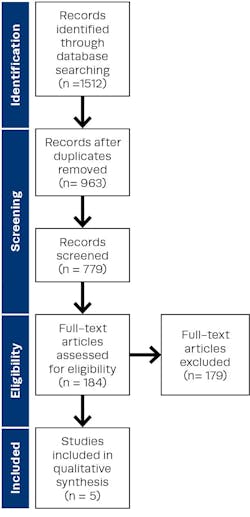Incidence and prevention of white spot lesions during removable orthodontic treatment: A systematic literature review
Abstract
Objectives: The aim of this study is to evaluate the appearance of white spot lesions during removable orthodontic treatment and methods to limit their formation.
Material and methods: A literature search for both observational and controlled studies on humans published from 2016 to 2023 was conducted on PubMed, ScienceDirect, and Google Scholar. 184 articles were reviewed.
Results: A total of five clinical studies fulfilled all inclusion search criteria. In these clinical studies, it was concluded that proper hygiene of aligners diminishes the chances of forming white spot lesions. Biofilm formation is limited since the aligners are typically swapped out after 14 days at most. It is important to use an ultrasonic bath to clean aligners, brush them with a toothbrush, avoid eating with the aligners in the mouth, and brush the teeth after eating prior to reinserting the aligners.
Conclusions: Removable orthodontic treatment does cause an increase in white spot lesions. However, by implementing good oral hygiene practices, the incidence of white spot lesions can be mitigated.
Keywords: White spot lesion, orthodontic treatment, clear aligners, Invisalign, Clear Correct, removable orthodontic appliance, oral hygiene, fluoride, photodynamic inactivation.
Introduction
White spot lesions (WSLs) indicate a demineralization in the enamel during orthodontic treatment. A natural consequence of introducing a removable orthodontic appliance (e.g., clear aligner, Invisalign, ClearCorrect) into the mouth of a patient is increasing the number of cariogenic bacteria present in the oral cavity, which stimulates the demineralization process.1,2 One such bacteria is Streptococcus mutans, which is known for its acid-producing properties. Due to this characteristic, when S. mutans is present in the oral cavity, it causes more rapid demineralization and is known to cause WSLs.2 Lactobacillus is another such bacteria.3
Since clear aligners cover the surface of the teeth, natural buffering, cleansing, and remineralization properties through salivary self-cleaning are interrupted.4 This is another mechanism that can contribute to the formation of WSLs during removable orthodontic treatment. Moreover, it creates a risk for plaque to develop under the aligners.5 Notably, clear aligner therapy often requires bonded attachments to the teeth, which cover a significant portion of the tooth surface. Patients require specific instructions regarding proper hygiene to offset food entrapment. The latter is more likely to occur with angular, sharp-edged attachments than with smooth, circular attachments.3,4
Another unique issue posed by clear aligners is that patients might consume sugary beverages while wearing the appliances. These beverages are known to increase plaque formation, which causes enamel demineralization. Drinking sugary beverages while aligners are in place poses a further risk of demineralization, as well as WSLs and decay.6
You may also be interested in ... White spot be gone: A minimally invasive approach with long-term results
Limiting the appearance of WSLs is one of the goals of orthodontic treatment. Some known methods to minimize their formation include the use of toothpaste with a high fluoride concentration, rinsing with a fluoride mouthwash, photodynamic inactivation, and use of an ultrasonic bath to clean the aligners.7-10
Various clinical studies have explored the development of WSLs while using clear aligners. However, the most effective method at limiting their formation remains unknown. The aim of this review is to evaluate the incidence of WSLs during removable orthodontic treatment and the effectiveness of different preventive methods.
Materials and methods
A comprehensive, systematic search of the medical literature was conducted in PubMed, ScienceDirect, and Google Scholar databases between April and May 2023. This systematic review of the literature employed the Preferred Reporting Items for Systematic Reviews and Meta-Analyses (PRISMA) method to minimize bias and facilitate replication.11 PRISMA consists of a 17-item checklist and a flowchart to ensure the identification, screening, and inclusion of articles.11 As is standard procedure,12,13 once the research questions have been determined, a protocol was established that included a search strategy, article inclusion/exclusion criteria, quality assessment, screening criteria, data extraction, and reporting strategy. The protocol contributes to the quality assurance of the systematic review process to avoid human bias.12
This study used the following characteristics as eligibility criteria: articles covering the period 2016–2023; clinical and observational studies published in English language; patients of any age undergoing orthodontic treatment with removable appliances evaluated for the progression of WSLs, or methods to prevent WSLs; and information that was either peer-reviewed or published in a high-impact journal.
The study sought to capture the most recent literature on the research focus, while also collecting enough evidence to make reliable conclusions. Furthermore, considering only peer-reviewed articles allowed for an iterative peer review process that ensures trustworthiness and accuracy.14 Studies that were not written in English, not published after 2015, did not research the use of removable appliances, or analyze progression of WSLs throughout the treatment were removed from the analysis.
You may also be interested in ... The "harmless-looking" white lip lesion that got ignored
The following search strategy was employed to ensure that the search terms were found in either the title, abstract, or keywords of the article: TS=(“white spot lesion” OR “Streptococcus mutans” OR “Lactobacillus” OR “demineralization” OR “removable appliances”) AND (“clear aligners” OR “Invisalign) OR TS=(“white spot lesion”) OR “Streptococcus mutans” OR “Lactobacillus” OR “demineralization” OR “removable appliances”) AND (“clear aligners” OR “Invisalign”) OR AB=((“white spot lesion”) OR “Streptococcus mutans” OR “Lactobacillus” OR “demineralization” OR “removable appliances”) AND (“clear aligners” OR “Invisalign)) AND PY=2016:2023 AND LANGUAGE=(English) AND (SO=(“Journal”)).
The process for selecting the studies followed a series of steps. First, a list of all articles identified in the search was compiled. This list underwent title and abstract screening to select those that met the predetermined eligibility criteria. Once articles were selected, they were reviewed in full and assessed for quality. The quality of each selected study was then evaluated against the criteria of the study. Finally, accepted articles were included in the systematic literature review.
Results
The screening process resulted in 1,512 studies that were initially collected from the selected databases. After removing duplicates, 963 unique studies remained. These studies were further screened based on their titles and abstracts, resulting in the exclusion of 779 studies due to lack of relevance to the research objectives. The remaining 184 papers underwent a full-text review, during which an additional 179 studies were excluded for diverse reasons such as inappropriate study design, insufficient data, and unrelated contents. Of the 184 articles reviewed, five clinical studies met the inclusion criteria and were included in this systematic review, as shown in Figure 1. These studies focused on the development of white spot lesions during removable orthodontic treatments.
The findings of the reviewed studies suggested that proper oral hygiene practices play a crucial role in minimizing the formation of WSLs. Regular and thorough cleaning of the aligners is essential to limit biofilm formation.15 Aligners should be cleaned using an ultrasonic bath, brushed with a toothbrush, and not worn while eating. Likewise, patients should be instructed to brush their teeth after meals before reinserting the aligners.
The use of high-fluoride-concentration toothpaste and rinsing with a fluoride mouthwash can help prevent demineralization and reduce the risk of WSL formation.16 These fluoride-based preventive measures can aid in maintaining the mineral balance of the enamel and promote remineralization.
Another potential preventive method mentioned in the literature is photodynamic inactivation. This technique involves the use of a photosensitizer and light to selectively target and destroy cariogenic bacteria, such as S. mutans, while minimizing damage to healthy tissues.17 Although further research is needed to determine its effectiveness in preventing WSLs during removable orthodontic treatment, photodynamic inactivation shows promise as a preventive strategy.
Discussion
The development of WSLs during orthodontic treatment has been a well-documented concern.17-19 These lesions represent the initial stage of tooth decay and can significantly affect the esthetic outcome of orthodontic treatment. The use of clear aligners, such as Invisalign and ClearCorrect, has gained popularity in recent years due to their esthetic appeal and convenience.20,21 However, the literature suggests that clear aligner treatment is not exempted from the risk of WSL formation.
The reviewed studies further highlight the importance of maintaining good oral hygiene during removable orthodontic treatment. Proper cleaning of the aligners is crucial to prevent the accumulation of plaque and the formation of biofilm, both of which contribute to the demineralization of enamel and the development of WSLs. Patients should be educated on the appropriate methods of cleaning aligners, including the use of an ultrasonic bath, brushing with a toothbrush, and avoiding wearing aligners while eating. Fluoride-based preventive measures have shown promise in reducing the risk of WSL formation.22 Fluoride toothpaste with a higher concentration than standard toothpaste, as well as fluoride mouthwash, can help maintain the mineral balance in the enamel and promote remineralization. These preventive strategies aim to strengthen the enamel and make it more resistant to acid-induced degradation.
Photodynamic inactivation is an emerging technique that shows potential in preventing WSL formation during orthodontic treatment. By selectively targeting cariogenic bacteria, such as S. mutans, this technique can help reduce the bacterial load in the oral cavity and minimize the risk of demineralization.23,24 Photodynamic inactivation shows promise as a preventive strategy, but more research is needed to determine efficacy and safety in removable orthodontic treatment.
Based on the findings, it can be established that removable orthodontic treatment using clear aligners increases the risk of WSL formation.25 However, the incidence of WSLs can be minimized by implementing proper oral hygiene practices and preventive measures such as regular aligner cleaning and the use of fluoride-based products (and potentially photodynamic inactivation).
It is important for orthodontic practitioners to educate patients about the potential risks and preventive strategies associated with removable orthodontic treatment. By promoting proper oral hygiene and providing appropriate instructions on preventive strategies, clinicians can help patients maintain their oral health and reduce the occurrence of WSLs. Patient compliance plays a significant role in preventing WSLs, and clear instructions and continuous support should be provided throughout the treatment process.26
Conclusion
The occurrence of WSLs during orthodontic treatment can be minimized by correct application of oral hygiene habits and preventive measures. Removable orthodontic therapy, such as utilizing transparent aligners, can induce an increase in these lesions. To minimize the incidence of WSLs, clean the aligners using an ultrasonic bath, brush them with a toothbrush, and avoid eating when wearing aligners. Rinsing with a fluoride mouthwash and using a high--fluoride-concentration toothpaste can aid in preserving the mineral balance in the enamel and facilitating remineralization. While photodynamic inactivation is a promising preventive method, more research is needed to validate its usefulness.
Patient compliance is crucial for appropriate oral hygiene and the prevention of WSLs. Clinicians should ensure that patients are well informed about the potential dangers and preventive actions associated with orthodontic treatment and give them clear instructions and support.
Although the reviewed studies provide valuable insights into preventive strategies, it is important to note their limitations. The number of studies available on this specific topic is relatively small, indicating a need for more research. Additionally, the included studies primarily focused on clear aligner treatment, and the generalizability of the findings to other types of removable orthodontic appliances may be limited.
Future research is warranted and should aim to investigate the long-term effectiveness of different preventive methods and develop standardized protocols for WSL prevention during removable orthodontic treatment. Studies comparing the incidence of WSLs between various types of removable orthodontic appliances will provide valuable insights into their relative risks and benefits.
Editor's note: This article appeared in the May 2024 print edition of Dental Economics magazine. Dentists in North America are eligible for a complimentary print subscription. Sign up here.
References
- Esper MÂLR, Junqueira JC, Uchoa AF, et al. Photodynamic inactivation of planktonic cultures and Streptococcus mutans biofilms for prevention of white spot lesions during orthodontic treatment: an in vitro investigation. Am J Orthod Dentofacial Orthop. 2019;155(2):243-253. doi:10.1016/j.ajodo.2018.03.027
- Mummolo S, Tieri M, Nota A, et al. Salivary concentrations of Streptococcus mutans and Lactobacilli during an orthodontic treatment. An observational study comparing fixed and removable orthodontic appliances. Clin Exp Dent Res. 2020;6(2):181-187. doi:10.1002/cre2.261
- Santonocito S, Polizzi A. Oral microbiota changes during orthodontic treatment. Front Biosci (Elite Ed.). 2022;14(3):1-4. doi:10.31083/j.fbe1403019
- Bisht S, Khera AK, Raghav P. White spot lesions during orthodontic clear aligner therapy: a scoping review. J Orthod Sci. 2022;11(1):9. doi:10.4103/jos.jos_170_21
- Moshiri M, Eckhart JE, McShane P, German DS. Consequences of poor oral hygiene during aligner therapy. J Clin Orthod. 2013;47(8):494-498.
- Azeem M, Hamid WU. Incidence of white spot lesions during orthodontic clear aligner therapy. J World Fed Orthod. 2017;6(3):127-130. doi:10.1016/j.ejwf.2017.07.001
- Liberati A, Altman DG, Tetzlaff J, et al. The PRISMA statement for reporting systematic reviews and meta-analyses of studies that evaluate health care interventions: explanation and elaboration. J Clin Epidemiol. 2009;62(10):e1-e34. doi:10.1016/j.jclinepi.2009.06.006
- Buschang PH, Chastain D, Keylor CL, Crosby D, Julien KC. Incidence of white spot lesions among patients treated with clear aligners and traditional braces. Angle Orthod. 2019;89(3):359-364. doi:10.2319/073118-553.1
- Albhaisi Z, Al-Khateeb SN, Alhaija ESA. Enamel demineralization during clear aligner orthodontic treatment compared with fixed appliance therapy, evaluated with quantitative light-induced fluorescence: a randomized clinical trial. Am J Orthod Dentofacial Orthop. 2020;157(5):594-601. doi:10.1016/j.ajodo.2020.01.004
- Zhao R, Huang R, Long H, Li Y, Gao M, Lai W. The dynamics of the oral microbiome and oral health among patients receiving clear aligner orthodontic treatment. Oral Dis. 2020;26(2):473-483. doi:10.1111/odi.13175
- Selçuk AA. A guide for systematic reviews: PRISMA. Turk Arch Otorhinolaryngol. 2019;57(1):57-58.
- Jiang X, Wang R, Chang T, et al. Effect of short-term air pollution exposure on migraine: a protocol for systematic review and meta-analysis on human observational studies. Environ Int. 2023;174:107892. doi:10.1016/j.envint.2023.107892
- Sabbagh H, Othman M, Khogeer L, Al-harbi H, Al harthi A, Abdulgader Yaseen Abdulgader A. Parental acceptance of silver diamine fluoride application on primary dentition: a systematic review and meta-analysis. BMC Oral Health. 2020;20(1):227. doi:10.1186/s12903-020-01195-3
- Recio-Saucedo A, Crane K, Meadmore K, et al. What works for peer review and decision-making in research funding: a realist synthesis. Res Integr Peer Rev. 2022;7(1):1-28. doi:10.1186/s41073-022-00120-2
- Charavet C, Gourdain Z, Graveline L, Lupi L. Cleaning and disinfection protocols for clear orthodontic aligners: a systematic review. Healthcare (Basel). 2022;10(2):340. doi:10.3390/healthcare10020340
- Pilli LN, Singaraju GS, Nettam V, Keerthipati T, Mandava P, Marya A. An extensive comparison of the clinical efficiency of acidulated phosphate fluoride (APF) and neutral sodium fluoride (NaF) oral rinses in the prevention of white spot lesions during fixed orthodontic treatment: a randomized controlled trial. BioMed Res Int. 2022:2022:6828657. doi:10.1155/2022/6828657
- Mollabashi V, Heydarpour M, Farmani A, Saadat K, Farhadian M. Remineralization effect of bioactive glass toothpaste versus sodium fluoride toothpaste on white spot lesions around orthodontic brackets: an in vitro study. Iranian J Orthod. 2022;17(2):1-7. doi:10.22034/ijo.2022.552106.1063
- Tahmasbi S, Mousavi S, Behroozibakhsh M, Badiee M. Prevention of white spot lesions using three remineralizing agents: an in vitro comparative study. J Dent Res Dent Clin Dent Prospects. 2019;13(1):36-42. doi:10.15171/joddd.2019.006
- Ramezani K, Ahmadi E, Etemadi A, Kharazifard MJ, Omrani LR, Akhoundi MSA. Combined effect of fluoride mouthwash and sub-ablative Er:YAG laser for prevention of white spot lesions around orthodontic brackets. Open Dent J. 2022;16(1). doi:10.2174/18742106-v16-e2208170
- Tartaglia GM, Mapelli A, Maspero C, et al. Direct 3D printing of clear orthodontic aligners: current state and future possibilities. Materials (Basel). 2021;14(7):1799. doi:10.3390/ma14071799
- Shukur I. Invisalign vs braces: which is right for you? A guide from an orthodontist: case of Blanca Dental Care. OTS Canadian J. 2023;2(4):1-8. doi:10.58840/ots.v2i4.17
- Philip N. State of the art enamel remineralization systems: the next frontier in caries management. Caries Res. 2019;53(3):284-295. doi:10.1159/000493031
- Inchingolo AD, Malcangi G, Semjonova A, et al. Oralbiotica/oralbiotics: the impact of oral microbiota on dental health and demineralization: a systematic review of the literature. Children (Basel). 2022;9(7):1014. doi:10.3390/children9071014
- Zou J, Du Q, Ge L, et al. Expert consensus on early childhood caries management. Int J Oral Sci. 2022;14(1):35. doi:10.1038/s41368-022-00186-0
- Burnheimer JM, Serio CG, Loo BH, Hartsock LA. Prevalence of white spot lesions and risk factors associated with the COVID-19 pandemic. J World Fed Orthod. 2022;11(4):125-129. doi:10.1016/j.ejwf.2022.03.003
- Weyland MI, Jost-Brinkmann PG, Bartzela T. Management of white spot lesions induced during orthodontic treatment with multibracket appliance: a national-based survey. Clin Oral Investig. 2022;26(7):4871-4883. doi:10.1007/s00784-022-04454-5
Chelsea Goldmeier is a D3 at Case Western Reserve University School of Dental Medicine. She is passionate about taking a preventive approach to dentistry by educating her patients. In her free time, she can be found at home with her three kids reading stories and playing games.
About the Author

Chelsea Goldmeier
Chelsea Goldmeier is a D3 at Case Western Reserve University School of Dental Medicine. She is passionate about taking a preventive approach to dentistry by educating her patients. In her free time, she can be found at home with her three kids reading stories and playing games.
Updated April 10, 2024

